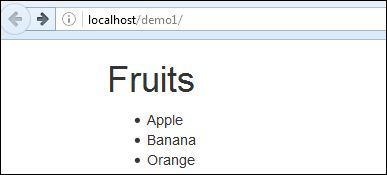Specifically in Phalcon, the view consists of Volt code, PHP and HTML. A set of special delimiters is available to enter in Volt mode. {% ... %} is used to execute statements such as for-loops or assign values, and {{ ... }} prints the result of an expression to the template.
Views in Phalcon are basically classified into two types −
- Volt
- phtml
Volt
Following is the screenshot of the output we had created for the project demo1 in the previous chapter. This output is achieved with the help of file views/index/index.volt.
This output is achieved with the help of file views/index/index.volt.Features of Volt Files
- It is a template written in C language and is considerably fast as compared to other languages.
- It includes a set of highly integrated components, which are very beneficial in Phalcon.
- It can also be used as a stand-alone component.
- Volt is compiled to pure PHP code.
<!--<div class = "page-header"> <h1>Congratulations!</h1> </div>--> <p>This is my first web application in Phalcon </p> <!--<p>You're now flying with Phalcon. Great things are about to happen!</p> <p>This page is located at <code>views/index/index.volt</code></p>-->
Hierarchical Rendering
Views in Phalcon support hierarchical rendering and Phalcon\Mvc\View is used as default rendering component. This component uses PHP as template engine in comparison with volt files which uses C as a template language.These views should have .phtml extension. The default directory of views for the given project consists of the following three files −
- Action view − This view is called to execute a particular action. It is called when “show” action is executed.
- Controller layout − This view is present inside the layouts folder. For example, C:\xampp\htdocs\demo\app\views\layouts. It invokes the method calls associated with the appropriate controller. The code implemented in layout will be implemented as and when required.
- Main layout − This layout view will invoke the main action and it will be shown for every controller or action within the web application.
Difference between .volt and .phtml Files
| .volt | .phtml |
|---|---|
| .volt extension is used when the template engine set up in the application is written in C | .phtml is used when the template engine is PHP itself |
| It can be used as a stand-alone component | It cannot be used as a stand-alone component |
| Volt views are compiled to PHP code | phtml files itself includes PHP code so there is no need of compilation in Phalcon framework |
Variables
Variables are assigned and changed in the template using 'set'.Declaring an array
{% set fruits = ['Apple', 'Banana', 'Orange'] %}
Declaring a string
{% set name = ”John Kennedy” %}
Comments
Comments may also be added to a template using the {# ... #} delimiters. All text inside them is just ignored in the final output.{# note: this is a comment {% set price = 100; %} #}
Example
{% set fruits = ['Apple', 'Banana', 'Orange'] %} <h1>Fruits</h1> <ul> {% for fruit in fruits %} <li>{{ fruit|e }}</li> {% endfor %} </ul> {% set robots = ['Voltron', 'Astro Boy', 'Terminator', 'C3PO'] %} <ul> {% for robot in robots %} <li>{{ robot }}</li> {% endfor %} </ul>
Output
The code will produce the following output screen −

No comments:
Post a Comment